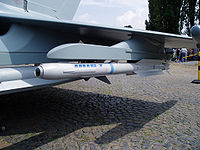
Photo from wikipedia
For certain engagements against small and fast-moving targets at higher altitude, an available total flight time during the terminal homing phase is short due to the limited performance of onboard… Click to show full abstract
For certain engagements against small and fast-moving targets at higher altitude, an available total flight time during the terminal homing phase is short due to the limited performance of onboard seekers to detect and track the target, and the autopilot performance of an aerodynamically controlled missile can degrade due to low air density and low dynamic pressure. To increase the lethality of warheads, sometimes terminal zero acceleration, corresponding to zero angle of attack at the instant of interception, is also required. This article proposes a new rapid homing guidance law, which can achieve the terminal zero miss-distance and zero-acceleration response under these severe engagements mentioned earlier. For deriving state feedback form commands that can be implemented to arbitrary order autopilot systems, the polynomial-function-based guidance design method and time-delay estimation method are adopted by introducing a jerk command and more general autopilot dynamics. The characteristics and performance of the proposed guidance law are demonstrated by performing various numerical linear simulations and adjoint simulations, including model uncertainties.
Journal Title: IEEE Transactions on Aerospace and Electronic Systems
Year Published: 2022
Link to full text (if available)
Share on Social Media: Sign Up to like & get
recommendations!